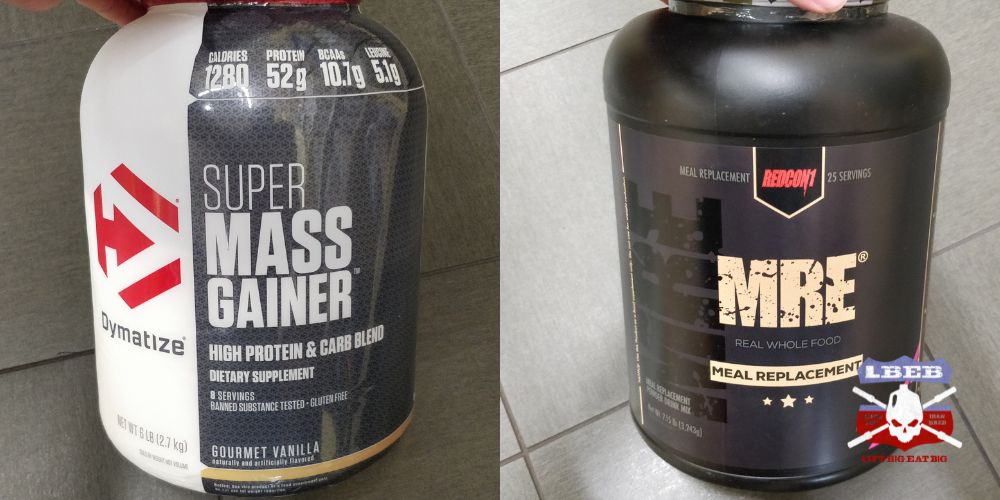I was walking through my local Vitamin Shoppe, looking at the various supplements on the shelf. Repeatedly I’d see “mass gainer” or “meal replacement” supplements that look remarkably similar. Both were high calorie and said they’d help build muscle. So, what’s the difference?
The main difference between a mass gainer and meal replacement is the ingredients and serving size. Mass gainers typically use simple carbohydrates and have double the caloric value per serving. In contrast, meal replacements use whole food ingredients.
This isn’t always the case, but it typically rings true. So, how do you know which one to choose?
Table of Contents
What Is Mass Gainer?
Mass gainer is a protein and carbohydrate-based powder formulation used to make consuming excess calories more manageable. Pounding another steak with potatoes doesn’t fit in your stomach at some point. But you can sip on liquid as you sink into the couch in a food coma.
They range massively in ingredients and serving sizes. For example, some mass gainers recommend a serving size of a couple of hundred grams and others well over 300 g equalling 2 & ½ cups!
What Is A Meal Replacement?
A meal replacement is similar to a mass gainer, a protein and carbohydrate-based powder formulation serving as a drinkable meal. Meal replacements typically use whole food ingredients to create a meal that isn’t loaded with simple carbohydrates. But this isn’t exclusive to meal replacements, and they often make great mass gainers.
Mass Gainer vs. Meal Replacement: What’s The Difference?

There isn’t any real difference between a mass gainer and meal replacement. Its marketing and supplements are labeled as either or can be used for either purpose. But some of these supplements are better suited than others.
Purpose
A mass gainer serves to create an easy-to-consume drink loaded with calories to help you gain weight and build muscle. A meal replacement is a meal in powdered form. It is often used by busy people who don’t have time to prepare a whole food meal and need something on the go.
Often, mass gainers and meal replacements are interchangeable. However, the reason you take the supplement may differ depending on your goals or day’s activity. For example, someone who doesn’t lift may use a meal replacement when running between meetings all day as there’s no time to sit and have a meal.
A skinny guy gaining weight may use the same meal replacement or mass gainer as an extra meal to create a caloric surplus.
Ingredients
Typically, a mass gainer uses simple carbohydrates like maltodextrin for the bulk of the formulation mixed with whey protein. Meal replacements often use whole food sources like ground oats and sweet potato flour.
This isn’t a hard and fast rule as some mass gainers also used whole food sources like my recommended Crazy Nutrition Mass Gainer.
What you don’t want is to use a mass gainer that is 1200 calories per serving as a meal replacement. That’s a double meal replacement and not going to serve you well. Also, having 200+ grams of carbohydrates from maltodextrin doesn’t provide you with any essential micronutrients.
Serving Sizes
Most mass gainers contain over 1000 calories per serving, while meal replacements provide a modest 500-600 calories per serving. This isn’t always the case, but it’s something to be aware of, especially since you don’t need to eat 1000 calories over your maintenance to build muscle.
Can Mass Gainer Be Used As A Meal Replacement?
A mass gainer can be used as a meal replacement and is a great option. Generally, the term “mass gainer” or “meal replacement” are marketing tactics. All that matters is you get sufficient protein and carbohydrates from whole food sources and serving sizes that aren’t giant.
Mass Gainer vs. Meal Replacement: Which Should You Get?
Instead of choosing between a mass gainer and a meal replacement, look at the ingredients and serving size. It doesn’t matter what the supplement is labeled as. You want to pick one that uses whole food sources for carbohydrates and has at least 50 g of protein per serving.
Often, you’ll want to cut the serving size in half, giving you approximately 25 g of protein per meal. In this case, you can add more whey protein to your shake to make it more macro-friendly and easier to hit your daily protein target.
